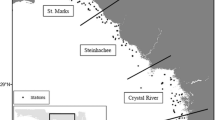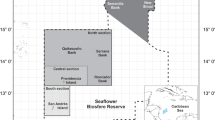Abstract
Dramatic declines in populations of large elasmobranchs, as well as the potential release of elasmobranch mesopredators, have led to interest in the ecological role of this group of fishes. The first step to elucidating their ecological importance, however, is an understanding of elasmobranch community structure. Such studies are relatively uncommon, especially in communities where human impacts are thought to be low. We used visual surveys and a variety of capture methods to determine spatial and temporal variation in the species composition of a sandflat elasmobranch community in the relatively pristine ecosystem of Shark Bay, Australia. Overall, juvenile batoids dominated the community. Eleven elasmobranch species (10 batoids, 1 shark) were found to inhabit the sandflats during the cold season (June–August) and 21 species (12 batoids, 9 sharks) were recorded during the warm season. The overall density of elasmobranchs occupying the sandflat was also higher during the warm season. Nearshore areas, especially during the warm season, supported the highest densities of elasmobranchs overall as well as the dominant species (giant shovelnose ray, Glaucostegus typus, and reticulate whipray, Himantura uarnak). Such high elasmobranch abundance may be driven by a combination of factors including prey availability, predator avoidance, and behavioral thermoregulation. The high species richness and density of elasmobranchs in such a restricted area suggest that elasmobranch mesopredators could exert strong top-down impacts in nearshore environments in the absence of human impacts, but raises questions of how resources are partitioned among apparently similar species in this system.








Similar content being viewed by others
References
Baum JK, Myers RA, Kehler DG, Worm B, Harley SJ, Doherty PA (2003) Collapse and conservation of shark populations in the Northwest Atlantic. Science 299:389–392
Berger KM, Conner MM (2008) Recolonizing wolves and mesopredator suppression of coyotes: impacts on pronghorn population dynamics. Ecol Appl 18:599–612
Blaber SJM, Brewer DT, Harris AN (1994) Distribution, biomass and community structure of demersal fishes of the Gulf of Carpentaria, Australia. Aust J Mar Freshw Res 45:375–396
Black R, Robertson AI, Peterson CH, Peterson NM (1990) Fishes and benthos of near-shore seagrass and sandflat habitats at Monkey Mia Shark Bay, Western Australia. In: Berry PF, Bradsaw SD, Wilson BR (eds) Research in Shark Bay: report of the France-Australe bicentenary expedition committee. Western Australia Museum, Perth, pp 245–261
Carrier JC, Pratt HL, Castro JI (2004) Reproductive biology of elasmobranchs. In: Carrier JC, Musick JA, Heithaus MR (eds) Biology of sharks and their relatives. CRC Press, New York, pp 487–521
Cartamil DP, Vaudo JJ, Lowe CG, Wetherbee BM, Holland KN (2003) Diel movement patterns of the Hawaiian stingray, Dasyatis lata: implications for ecological interactions between sympatric elasmobranch species. Mar Biol 142:841–847
Casey JG, Kohler NE (1992) Tagging studies on the shortfin mako shark (Isurus oxyrinchus) in theWestern North Atlantic. Aust J Mar Freshw Res 43:45–60
Compagno LJV, Last PR, Stevens JD, Alava MNR (2005) Checklist of Philippine chondrichthyes. CSIRO Marine Laboratories, Rept 243
Connor RC, Heithaus MR (1996) Great white shark approach elicits flight response in bottlenose dolphins. Mar Mamm Sci 12:602–606
Cope JM (2006) Exploring intraspecific life history patterns in sharks. Fish Bull 104:311–320
Economakis AE, Lobel PS (1998) Aggregation behavior of the grey reef shark, Carcharhinus amblyrhynchos, at Johnston Atoll, central Pacific Ocean. Environ Biol Fish 51:129–139
Frisk MG, Miller TJ (2009) Maturation of little skate and winter skate in the western Atlantic from Cape Hatteras to Georges Bank. Mar Coast Fish Dyn Manag Ecosyst Sci 1:1–11
Heithaus MR (2001) The biology of tiger sharks, Galeocerdo cuvier, in Shark Bay, Western Australia: sex ratio, size distribution, diet, and seasonal changes in catch rates. Environ Biol Fish 61:25–36
Heithaus MR (2004a) Fish communities of subtropical seagrass meadows and associated habitats in Shark Bay, Western Australia. Bull Mar Sci 75:79–99
Heithaus MR (2004b) Predator–prey interactions. In: Carrier JC, Musick JA, Heithaus MR (eds) Biology of sharks and their relatives. CRC Press, New York, pp 487–521
Heithaus MR, Burkholder D, Hueter RE, Heithaus LI, Pratt HL, Carrier JC (2007a) Spatial and temporal variation in shark communities of the lower Florida Keys and evidence for historical population declines. Can J Fish Aquat Sci 64:1302–1313
Heithaus MR, Wirsing AJ, Frid A, Dill LM (2007b) Behavioral indicators in marine conservation: lessons from a pristine seagrass ecosystem. Israel J Ecol Evol 53:355–370
Heithaus MR, Frid A, Wirsing AJ, Worm B (2008) Predicting ecological consequences of marine top predator declines. Trends Ecol Evol 23:202–210
Heithaus MR, Frid A, Vaudo JJ, Worm B, Wirsing A (2010) Unraveling the ecological importance of elasmobranchs. In: Carrier JC, Musick JA, Heithaus MR (eds) Sharks and their relatives II: biodiversity, adaptive physiology, and conservation. CRC Press, New York (in press)
Hight BV, Lowe CG (2007) Elevated body temperatures of adult female leopard sharks, Triakis semifasciata, while aggregating in shallow nearshore embayments: evidence for behavioral thermoregulation? J Exp Mar Biol Ecol 352:114–128
Hoisington G IV, Lowe CG (2005) Abundance and distribution of the round stingray, Urobatis halleri, near a heated effluent outfall. Mar Environ Res 60:437–453
Holland KN, Wetherbee BM, Peterson JD, Lowe CG (1993) Movements and distribution of hammerhead shark pups on their natal grounds. Copeia 1993:495–502
Hutchins JB (1990) Fish survey of South Passage, Shark Bay, Western Australia. In: Berry PF, Bradsaw SD, Wilson BR (eds) Research in Shark Bay: report of the France-Australe bicentenary expedition committee. Western Australia Museum, Perth, pp 263–278
Kitchell JF, Essington TE, Boggs CH, Schindler DE, Walters CJ (2002) The role of sharks and longline fisheries in a pelagic ecosystem of the Central Pacific. Ecosystems 5:202–216
Last PR, Stevens JD (2009) Sharks and rays of Australia, 2nd edn. Harvard University Press, Cambridge
Last PR, Manjaji-Matsumoto BM, Pogonoski JJ (2008) Himantura astra sp. nov., a new whipray (Myliobatoidei: Dasyatidae) from northern Australia. In: Last PR, White WT, Pogonoski JJ (eds) Descriptions of new Australian chondrichthyans. CSIRO Marine and Atmospheric Res, Hobart, pp 303–314
Marshall AD, Kyne PM, Bennett MB (2008) Comparing the diet of two sympatric urolophid elasmobranchs (Trygonoptera testacea Muller and Henle and Urolophus kapalensis Yearsley and Last): evidence of ontogenetic shifts and possible resource partitioning. J Fish Biol 72:883–898
Matern SA, Cech JJ Jr, Hopkins TE (2000) Diel movements of bat rays, Myliobatis californica, in Tomales Bay, California: evidence for behavioral thermoregulation? Environ Biol Fish 58:173–182
Musick JA, Branstetter S, Colvocoresses JA (1993) Trends in shark abundance from 1974 to 1991 for the Chesapeake bight region of the US Mid-Atlantic coast. NOAA Tech Rept NMFS 115:1–18
Myers RA, Baum JK, Shepherd TD, Powers SP, Peterson CH (2007) Cascading effects of the loss of apex predatory sharks from a coastal ocean. Science 315:1846–1850
Peterson CH, Fodrie FJ, Summerson HC, Powers SP (2001) Site-specific and density-dependent extinction of prey by schooling rays: generation of a population sink in top-quality habitat for bay scallops. Oecologia 129:349–356
Platell ME, Potter IC, Clarke KR (1998) Resource partitioning by four species of elasmobranchs (Batoidea: Urolophidae) in coastal waters of temperate Australia. Mar Biol 131:719–734
Rayner MJ, Hauber ME, Imber MJ, Stamp RK, Clout MN (2007) Spatial heterogeneity of mesopredator release within an oceanic island system. Proc Natl Acad Sci 104:20862–20865
Shepherd TD, Myers RA (2005) Direct and indirect fishery effects on small coastal elasmobranchs in the northern Gulf of Mexico. Ecol Lett 8:1095–1104
Sinclair ARE, Mdumna SAR, Hopcraft JGC, Fryxell JM, Hilborn R, Thirgood S (2007) Long-term ecosystem dynamics in the Serengeti: lessons for conservation. Conserv Biol 21:580–590
Smith JW, Merriner JV (1987) Age and growth, movements and distribution of the cownose ray, Rhinoptera bonasus, in Chesapeake Bay. Estuaries 10:153–164
Smith WD, Cailliet GM, Melendez EM (2007) Maturity and growth characteristics of a commercially exploited stingray, Dasyatis dipterura. Mar Freshw Res 58:54–66
Soule ME, Bolger DT, Alberts AC, Wright J, Sorice M, Hill S (1988) Reconstructed dynamics of rapid extinctions of chaparral-requiring birds in urban habitat islands. Conserv Biol 2:75–92
Stobutzki IC, Miller MJ, Heales DS, Brewer DT (2002) Sustainability of elasmobranchs caught as bycatch in a tropical prawn (shrimp) trawl fishery. Fish Bull 100:800–821
Tews J, Brose U, Grimm V, Tielborger K, Wichmann MC, Schwager M, Jeltsch F (2004) Animal species diversity driven by habitat heterogeneity/diversity: the importance of keystone structures. J Biogeogr 31:79–92
Thrush SF, Pridmore RD, Hewitt JE, Cummings VJ (1991) Impact of ray feeding disturbances on sandflat macrobenthos: do communities dominated by polychaetes or shellfish respond differently? Mar Ecol Prog Ser 69:245–252
Thrush SF, Pridmore RD, Hewitt JE, Cummings VJ (1994) The importance of predators on a sandflat: interplay between seasonal changes in prey densities and predator effects. Mar Ecol Prog Ser 107:211–222
VanBaricom GR (1982) Experimental analyses of structural regulation in a marine sand community exposed to oceanic swell. Ecol Monogr 52:283–305
Vaudo JJ, Lowe CG (2006) Movement patterns of the round stingray Urobatis halleri (Cooper) near a thermal outfall. J Fish Biol 68:1756–1766
Wallman HL, Bennett WA (2006) Effects of parturition and feeding on thermal preference of Atlantic stingray, Dasyatis sabina (Lesueur). Environ Biol Fish 75:259–267
Wells FE, Rose RA, Lang S (1985) An analysis of benthic marine invertebrate communities in subtidal seagrass and sand habitats in Shark Bay, Western Australia. Rec West Aust Mus 12:47–56
White WT, Dharmadi (2007) Species and size compositions and reproductive biology of rays (Chondrichthyes, Batoidea) caught in target and non-target fisheries in eastern Indonesia. J Fish Biol 70:1809–1837
White WT, Potter IC (2004) Habitat partitioning among four elasmobranch species in nearshore, shallow waters of a subtropical embayment in Western Australia. Mar Biol 145:1023–1032
White WT, Hall NG, Potter IC (2002) Size and age compositions and reproductive biology of the nervous shark Carcharhinus cautus in a large subtropical embayment, including an analysis of growth during pre- and postnatal life. Mar Biol 141:1153–1164
White WT, Platell ME, Potter IC (2004) Comparisons between the diets of four abundant species of elasmobranchs in a subtropical embayment: implications for resource partitioning. Mar Biol 144:439–448
White WT, Last PR, Stevens JD, Yearsley GK, Fahmi, Dharmadi (2006) Economically important sharks and rays of Indonesia. ACIAR Publishing, Canberra
Wiley TR, Simpfendorfer CA (2007) The ecology of elasmobranchs occurring in the Everglades National Park, Florida: implications for conservation and management. Bull Mar Sci 80:171–189
Wirsing AJ, Heithaus MR, Dill LM (2006) Tiger shark (Galeocerdo cuvier) abundance and growth in a subtropical embayment: evidence from 7 years of standardized fishing effort. Mar Biol 149:961–968
Acknowledgments
We would like to thank everyone who helped in the field, especially David Heithaus, Kirk Gastrich, Meagan Dunphy-Daly, and Jimboy Poland. We also thank the Department of Environment and Conservation, Shark Bay District; Rory McAuley of the Department of Fisheries, Western Australia; the Monkey Mia Dolphin Resort for logistical matters; and Joel Trexler for statistical advise. This research was possible due to a Presidential Fellowship (to JJV), a grant from the National Geographic Expeditions Council (to JJV), National Science Foundation grants OCE0526065 and OCE0745606 to MRH, and Florida International University’s College of Arts and Sciences. This research was conducted under authorization by the Florida International University Institutional Animal Care and Use Committee, Fisheries Western Australia permit 4/05 and Department of Environment and Conservation permits CE002111 and SF006493. This is contribution no. 38 of the Shark Bay Ecosystem Research Project.
Author information
Authors and Affiliations
Corresponding author
Additional information
Communicated by R. Lewison.
Rights and permissions
About this article
Cite this article
Vaudo, J.J., Heithaus, M.R. Spatiotemporal variability in a sandflat elasmobranch fauna in Shark Bay, Australia. Mar Biol 156, 2579–2590 (2009). https://doi.org/10.1007/s00227-009-1282-2
Received:
Accepted:
Published:
Issue Date:
DOI: https://doi.org/10.1007/s00227-009-1282-2




